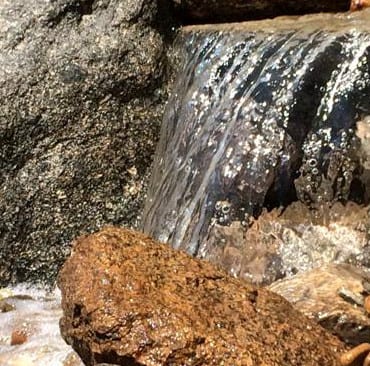by Trevor Smith
Water’s most amazing quality is that it is simultaneously part of the mystery of life and an essential element in the most mundane routines of life. We use it to cook, brush our teeth and wash our cars, but few can deny the majesty of a waterfall or resist watching waves crash on a beach.
Since ancient times humans have harnessed water to promote life and for entertainment. The Romans most famously created the aqueducts to bring life-giving water from great distances to population centers. They also famously celebrated water, creating ornate fountains in city squares – a celebration repeated around the world in public and private gardens, malls and airports.
Water is H2O, hydrogen two parts, oxygen one, but there is also a third thing that makes it water and nobody knows what it is. -D.H. Lawrence
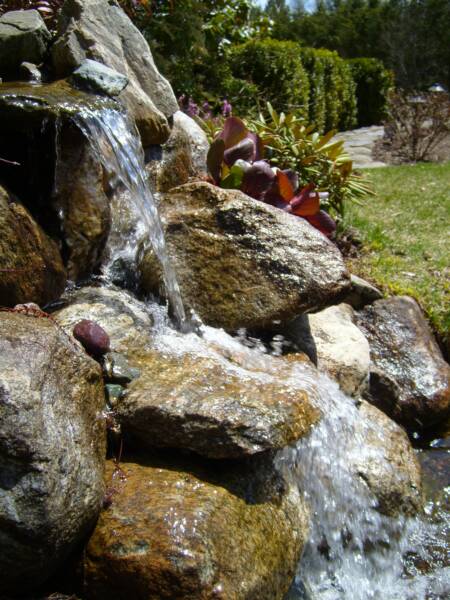
After finding out all I could about backyard water features, I learned to let the process control a project.
I have been in love with water since I was a child, exploring vernal pools and streams wherever they form, from mossy woods to the edges of parking lots. Working with water was one of the driving factors in my creation of Land Escape Design Inc., and in 2001, I dove into learning how to create backyard water features. I took every how-to class, watched every video and read dozens of books. By the time I sold and was ready to build my first feature – 11’x16′ with the falls on the side – I had information overload. I truly felt panic welling up because I wanted the project to be perfect, but I didn’t know which method to use or where to start. That’s when I decided just to start digging. I let the process take control and allowed the pond to build itself. That has been my approach ever since. Much later I learned this process respects the “genius loci” or the spirit of a place.
When I start a new project, I know the dimensions and I have an understanding of the pieces I want to include. I always give myself a little leeway when it comes to liner size to allow for a little onsite creativity. Then I rough out the general dimensions and allow the site to dictate the rest.
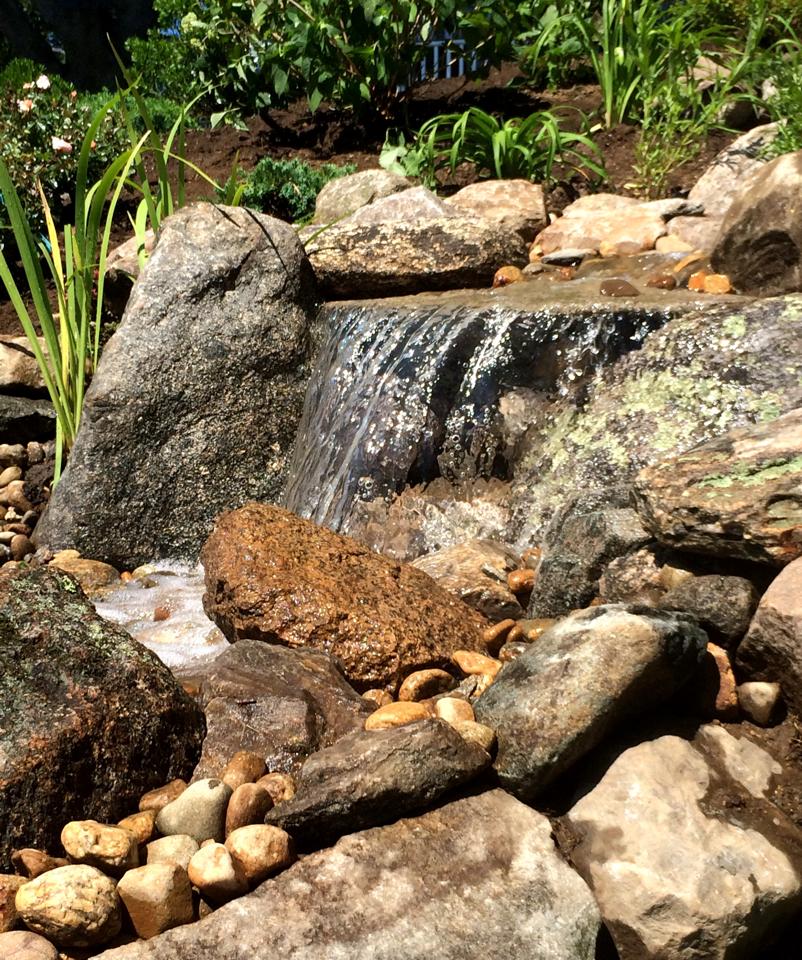
To create a water feature that looks natural in the landscape, it has to be believable, both visually and audibly.
Developing a Believable Stream
My goal always is to make the water feature as real and as believable as possible. This begins with a story. A typical story goes like this: Here is where a spring emerges from the earth. The water slowly carves its way down this slope and collects in the pond below. In the case of a pondless water feature, the story has the water winding its way before disappearing again underground.
To create a believable water feature the water must both look and sound believable. The second part of this equation, the sound, is the often overlooked in water feature construction. To look believable the stream and falls must fit the scale of the yard, e.g. a relatively flat yard would not have a huge crashing waterfall. Ponds and streams should not look like a pit of stone or a boulder necklace. They should incorporate natural edges with the landscape coming right up to the water. And the stream should include varying widths and depths and different types of falls. To sound believable, you should be able to hear SHHHH, Woshhhh, Gurgles, and Trickles.
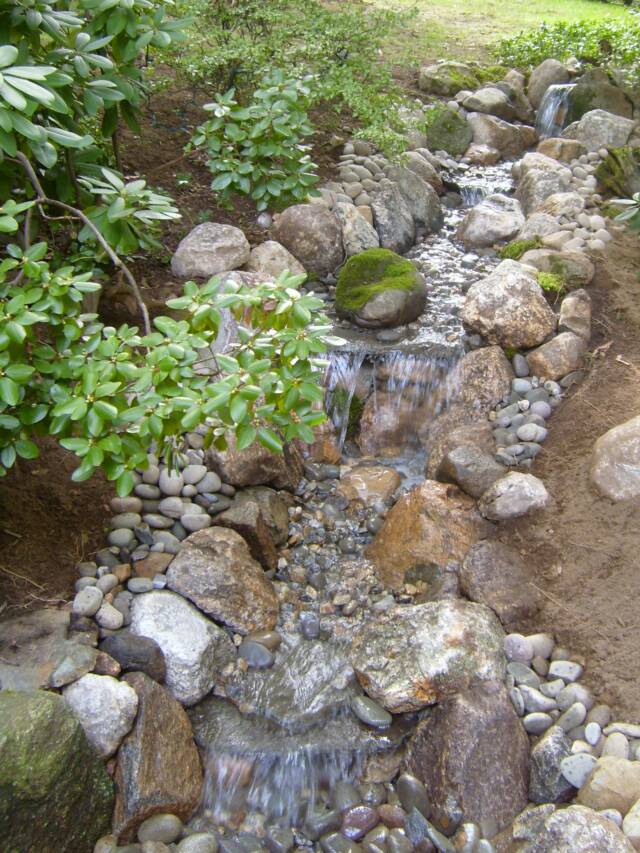
A stream designed with a variety of water falls that produce many different sounds offers visitors a rich experience.
The challenge and the fun come from orchestrating all these sounds into an aquatic chorus that echoes throughout the yard. To start, you need to know the types of waterfalls and the sounds they make.
Sheet falls are the most common type of constructed falls. Sheet falls are created as the water falls off a thin stone or one with a return cut (when a thicker stone has a sharp edge allowing the water to fall off without hugging the stone). These are the most dramatic and easiest to create which is why they are used so often. (Think mini golf course.) Sheet falls project a SHHHHH sound straight out from the water. The pitch of the falls varies by the depth of the water it crashes into and by the grotto behind. The deeper the pool the falls spill into the lower the pitch. The deeper the grotto behind the falls the more echo there is and the more robust the sound. Sheet falls are beautiful, dramatic and a necessary instrument in your orchestra, but they do not occur that frequently in nature so should not be overused.
Cascade falls or boulder falls are found fairly commonly in nature. When these falls occur, water rolls and spills over the face of large or multiple boulders, frothing and fracturing on the way down. Cascade falls are also very dramatic and only a little harder to create than sheet falls. These falls can be tiered, allowing water to spill gently from one rock to the next or to madly crash as the water rolls over and down the rock faces. The primary sound created by the cascade falls is the Woshhhhh, but you can also get some surprising burps and gurgles as well. I say surprising because there is always a little unknown when it comes to these falls. With waterfall foam and through careful design you can suggest how you want the water to roll and spill, but nature often varies what you were going for and produces a few unintended surprises and a variety of sounds.
Boulder tumble is the most common waterfall in nature and is often overlooked in water feature construction. Boulder tumbles are in-stream falls and occur at minor grade changes when the water is squeezed and sloshed between stones, usually at pinch points in the stream. These falls create low notes: gurgles, trickles and burps. If you close your eyes and picture a mountain stream or a woodland brook, these are the sounds you imagine. The gurgling, burping sounds of boulder tumbles are created by the turbulence as the water rolls onto itself swirling and creating undertow. The trickle sound is created by small drops, tight spills (picture water being poured from a pitcher), and fractures drips. The pitch of the trickle and tone of the gurgle depend on the volume of water being forced through the point and the depth of the stream at that point. These falls offer little to no drama, but they add depth to a stream’s song much like backup singers in a vocal performance.
Dips and ripples are created within the stream as it changes depth or as the water passes over a large flat stone or around a partially submerged stone. These areas naturalize the stream, emitting chirps, bloops and trickles. They also visually naturalize the stream and provide access points for wildlife to drink and bathe.
Tuning the Falls
You have thought this all through over and over in your mind. You have stared at the stones imagining the splash and the sound. Now you plug the pump in and wait as the water begins to trickle then finally spill from the waterfall weir. There is your SHHHH and Wooosh. As the stream fills you wait. There it is: high gurgle, bloop and trickle, then a low bloop followed by a high gurgle as the water makes its way to the pond below. Now it is time to tune the falls.
Start at the head of the stream and slowly make you way down listening. Listen to how the different noises fade in and out from the foreground to the background as you move along. What sounds do you notice most? What sounds are missing? At the sheet falls you may notice the SHHHH is too high pitched or too uniform. Try putting a 3-4 inch stone in the spillway before it falls over the weir. Move it around and listen to the sound change as you alter the flow so that water spills more heavily over one edge and less heavily on another. Or dig the gravel out where the falls enter the stream and listen to the pitch. Now place a small boulder in the flow of the sheet. This should create both a high and low SHHHHH.
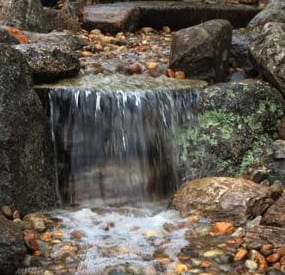
Click for a video highlighting each style of falls. Notice the way the water is moving, the way the boulders are situated and the sound produced. Play it a second time with your eyes closed and create the image in your mind.
Move down the stream. High gurgle, low bloop. Good, that’s what we were hoping for. Then high gurgle, high gurgle, high trickle. Wait back it up. Try digging the gravel out where the water rushes through the pinch point. As the water rushes into the deep water it will churn giving you a low gurgle.
After each change, go to the viewing area and close your eyes. Do you hear all the voices? Make your way down the stream and listen to it in sections tuning each one. For long streams with multiple viewing areas try to highlight a “voice” (sound) in each of them that then becomes part of the whole in the main viewing area. Do this until you have created a pleasing chorus.
Water is a primordial element and cannot truly be controlled. As with the rest of nature it takes great effort and resource to bend water to your will. The best way to design with water is to understand water and then do your best to mimic nature. For me this involves allowing intuition to take over. To orchestrate your aquatic chorus, the best thing to do is become familiar with the different voices and experiment with arranging them both in pitch and sequence. Warning: this process is extremely gratifying and may cause you to lose track of time. It seems like such a simple thing, to the point where you’d think it irrelevant, but a properly tuned falls and stream makes the difference between just a water feature and an authentic connection with nature.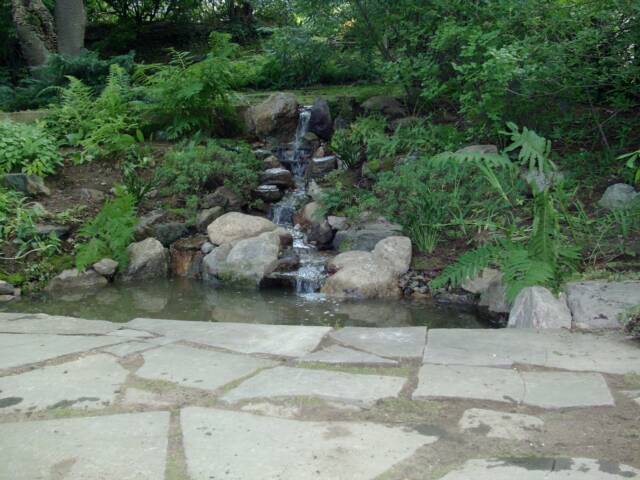
About the Author
Trevor Smith is the owner of Land Escapes, a full service ecological landscaping company in the Boston area that specializes in Garden Design, Eco-Rain Recovery, Water Features, and Living Wall Installations. Trevor is equally driven by both the form and function of his landscape designs: passionate about the natural world which inspires his commitment to ecological principles and practices; passionate about creating beautiful landscapes to provide clients with an oasis to reconnect with the natural world. Trevor holds several landscape certifications: MCH, NOFA AOLCP, LEEDGA, and IPCI. Trevor is also a past-President of the Ecological Landscape Alliance.
***
Each author appearing herein retains original copyright. Right to reproduce or disseminate all material herein, including to Columbia University Library’s CAUSEWAY Project, is otherwise reserved by ELA. Please contact ELA for permission to reprint.
Mention of products is not intended to constitute endorsement. Opinions expressed in this newsletter article do not necessarily represent those of ELA’s directors, staff, or members.

